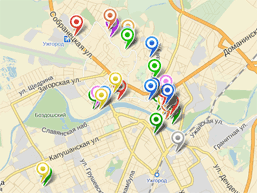Laboratory of Natural Ecosystems Protection
The Scientific Research Laboratory of Protection of Natural Ecosystems (SRL PNE) is a scientific subdivision of scintific research part of Uzhgorod National University. The laboratory was established in 1993 at the Department of Botany, Uzhgorod State University of Ministry of Education and State Department of Environmental Safety in the Transcarpathian region of Ministry of Ukraine. Nowadays is a powerful scientific collective, the main purpose of which is to develop the theoretical principles and practical measures to protect the nature of the Ukrainian Carpathians.
The areas of activity:
- complex study of the variety of the Transcarpathia’s flora;
- ecological bases of optimization of nature reserve fund of the Transcarpathia.
For the first direction, which was recognized in the scientific community not only in Ukraine, but also abroad, the team laboratory conducted studies of intraspecific structure, distribution, ecological, phytocoenotic and biomorphological characteristics, reproductive biology and demography endangered kinds of flora of the Eastern Carpathians. The mechanisms of adaptation model species of the plants to environmental conditions and actions of anthropogenic factors are disclosed, assessed their survival strategies and prospects for the use.
The taxonomic, floristic, population-biological and phyto-sociological studies conducted for the purpose of effective assess and develop strategies to preserve the variety of flora. Based on long-term studies of the flora and vegetation of the Ukrainian Carpathians, we proposed a synthetic approach that creates the necessary preconditions for successful preservation biodiversity of flora.
At the population level, for example the model group of ephemeroidical geophytes that endangered disclosed their taxonomic structure and intraspecific differentiation, found the features of population lives and ways of micro phylogeny, identified strategies of survival and protection of insitu.
At the species level, for example the model of rare species of Transcarpathia’s flora, studied their systematic, khorological, environmental cenotic and bio-morphological features on which held sozological categorization of rare phyto geno fund of the region and identified the main tasks of its conservation.
At the coenotic level, for example the model of rare communities highlands of the Ukrainian Carpathians, defined their syntaxonomical identity based on floral classification, described synmorphology, synekology, syndynamics, synkhorology and synphytosozology. The categorization conducted of rare phytocoenotic fund of the region and outlined the priorities of its conservation.
The integral use of genetic-evolutionary and ecological demographic methods allows come up with a new position to analyze of the modern state of diversity of flora and ensuring its conservation on the basic of structural functional levels. Therefore, the proposed synthetic approach is the further development of scientific bases of conservation and sustainable use of biodiversity and the environment in general.
The results of many years of research summarized in the monograph V. Krichfalushiy and V. Komendar "The Bioecology of Rare Species of Plants (for example of ephemeroid of the Carpathians)", as well as the collective work "The Rare Flora of the Transcarpathia."
In the field of floristry and autphytosozology a group of authors prepared work "The Red List of Transcarpathia: plant species and plant communities that are endangered." To publish a book as a separate edition the authors won on Grants UK's Systematic Association.
In the field of phytosociology and synphytosozology prepared generalizing work was prepared focusing on the investigation of vegetation highlands of the Ukrainian Carpathians, which was published by K. Malinowskiy and V. Krichfalushiy as the 1st volume of academic series "The Flora of Ukraine."
Also the inventory examines of wetland flora and vegetation of basin of the Tysa river. As a result of these studies in the monograph series, published in Hungary in 1999 printed the 4th volume was published focusing on environmental research of the Tysa valley, the co-authors of which are two employees of the laboratory (V. Krichfalushiy and A. Myhal).
V. Komendar for many years has been conducting research related to the studies of the problems of strengthening the protective function of mountain forests of the Carpathians. The results of this research are published in the monograph "The Outposts of the Mountain Forests." All this created the ways for successful implementation of the international project "The Submeadow forests of the Carpathian: management and conservation to promote sustainable development of the region" (2002-2002 years). A number of priority researches have been identified according to the results of research for providing the sustainable development of the Carpathian region, the directions of environmental research and conservation activities that would help to optimize the ecological balance and the prevention of dangerous natural processes.
In another direction the laboratory staff working on the problem of optimization of nature reserve fund of the region. A number of proposals have been prepared to create new protected territories of different status and improvement of the regime of protection the existing facilities, including projects of regional landscape parks "Prytysyansky" and "Irshavsky paradise." On the initiative basis continues monitoring studies in the Valley of daffodils (narcissuses) of the Carpathian biosphere reservation and learning of vegetation of Uzhan National Natural Park and the National Natural Park "Synevyr."
At present, the research of collective of the laboratory aimed at developing the conception of protection and sustainable use of plant resources of the region through the establishment of ecological networks and maintaining of floristic diversity. To its achievement handled the issue of the structure and distribution of rare phyto and tsenofond. The bioecological analysis of model species and organization of monitoring will ensure detection of impact unfavorable factors on the state of their populations. This will enable to single out the nucleus of biotsentries and assess the status of ecological corridors in the region. The obtained results will form the basis of development project of environmental network studied region, which will connect the general European and national ecological network.
In addition to scientific research work laboratory staff conduct an active public activities in the area of environmental protection - publish articles in popular magazines and newspapers (including foreign), make appearances on the radio and television, deliver lectures, organize and conduct seminars.
The official website of the SRL of Natural Ecosystems Protection
M. Polyuzhyn
29.10.2014








